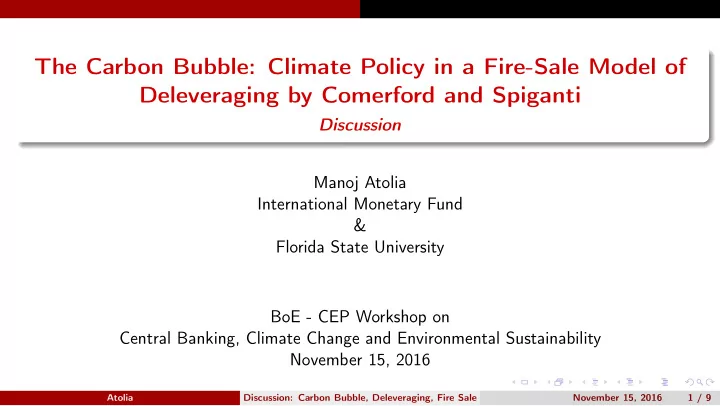

The Carbon Bubble: Climate Policy in a Fire-Sale Model of Deleveraging by Comerford and Spiganti Discussion Manoj Atolia International Monetary Fund & Florida State University BoE - CEP Workshop on Central Banking, Climate Change and Environmental Sustainability November 15, 2016 Atolia Discussion: Carbon Bubble, Deleveraging, Fire Sale November 15, 2016 1 / 9
Motivation Overview Fossil fuel stock vastly larger than cumulative allowable emission. Carbon Bubble: The valuation of fossil fuel assets is a bubble. So is also the valuation of companies using cheap fossil fuel. A quantitative economic analysis of implications of bursting of the carbon bubble. Amplification of bursting of carbon bubble through financial sector specifically through financial accelerator mechanism modeled as in Kiyotaki and Moore (1997). Feedback effects of macroeconomic effects of bursting of carbon bubble on transition to carbon-free world via impairment of investment in green technology, precisely when such investment is needed the most. What policies can mitigate the effects of this adverse spiralling mechanism? Atolia Discussion: Carbon Bubble, Deleveraging, Fire Sale November 15, 2016 2 / 9
Motivation Policy Analysis What policies can mitigate these adverse consequences? Tax Funded transfer of investors’ debt to government. 1 Good even otherwise. Transfer 90% of debt. Price of capital rises by 17% (versus 39% fall without.) Cumulative investment in zero carbon energy: 50% higher Welfare: 5% higher (Enterpreneurs: +73%; Savers: -11%) Subsidizing Investment: Untargeted (could be targeted.) 2 “Black box” distortion makes subsidy not beneficial otherwise. Optimal subsidy boosts productivity by 45%. Price of capital falls by only 2%. Cumulative investment in zero carbon energy: 40% higher Welfare: > 3% higher (Enterpreneurs: +49%; Savers: -7%) Atolia Discussion: Carbon Bubble, Deleveraging, Fire Sale November 15, 2016 3 / 9
Motivation Policy Analysis: Contd. What policies can mitigate these adverse consequences? Government guarantees on investors’ borrowings. 3 Free lunch Optimal guarantee: 20%. Price of capital falls by about 25%. Cumulative investment in zero carbon energy: 8% higher Welfare: About 3% higher (Entrepreneurs: +19%; Savers:0%) Deception: Announcing carbon budget, ˆ S , larger than 2 ◦ C target requirement. 4 Free lunch Optimal ˆ S : Consistent with 28% write off of high energy capital (versus 50%) Price of capital falls by about 15%. Cumulative investment in zero carbon energy: 12% higher Welfare: > 2% higher (Entrepreneurs: +17%; Savers:0%) Atolia Discussion: Carbon Bubble, Deleveraging, Fire Sale November 15, 2016 4 / 9
Motivation Comments: The big picture Are there some rational reasons why carbon assets are not being priced at zero? Atolia Discussion: Carbon Bubble, Deleveraging, Fire Sale November 15, 2016 5 / 9
Motivation Comments: The big picture Are there some rational reasons why carbon assets are not being priced at zero? Atolia Discussion: Carbon Bubble, Deleveraging, Fire Sale November 15, 2016 5 / 9
Motivation Overview of Approach Aggregrate Economy Y = A ˜ F ( K , L ) = A ˜ F ( K , 1 ) = AF ( K ) (1) P k = H ( A ) (2) Aggregrate Economy with resources Y = AF ( K ; X ) (3) P k = H ( A ; X ) (4) Aggregrate Economy with two types of capital Y = A × min { F ( K ; X 1 ) , G ( Z ; X 2 ) } (5) P k = H ( A ; X 1 , X 2 ) (6) What happens if X 2 falls due to government regulation and there are financial frictions? Atolia Discussion: Carbon Bubble, Deleveraging, Fire Sale November 15, 2016 6 / 9
Motivation Comments: Motivation and model What is the nature of financial frictions being captured by the model? Motivation: What assets are being mis-priced and, being collateralized, will lead to “fire-sale” dynamics? Primarliy: fossil fuel assets, i.e., “unburnable carbon” Also: companies using cheap fossil fuel Model: What assets are present and are being collateralized? Physical capital which is in constant supply and does not depreciate over time. Energy capital that is created from goods, but is not collateralized. The model has a steady state (in fact, a continuum of them), in absence of no action. How does one think of this vis-a-vis the real world where current situation cannot be considered as a steady state, in light of a finite supply of fossil fuels? Atolia Discussion: Carbon Bubble, Deleveraging, Fire Sale November 15, 2016 7 / 9
Motivation Comments: Data/Calibration and model Model: Technologies Dirty: y t = ( a H + c ) × min ( k t − 1 , z H t − 1 ) (7) Clean: y t = ( a L + c ) × min ( k t − 1 , z L t − 1 ) (8) a H > a L > 0 Data/Calibration: Calibration assumes: a L = c Data from EIA: “fossil fuel generation costs around 10% less per unit of energy supplied.” Calibration, therefore, sets a L = c = 0 . 9 a H a L + c = 1 . 8 a H a H + c = 1 . 9 a H = ⇒ and Perhaps there is scope to improve calibration here. Different ‘ φ ’ instead of different ‘ a ’ for dirty and clean technology? Atolia Discussion: Carbon Bubble, Deleveraging, Fire Sale November 15, 2016 8 / 9
Motivation Further Research Relaxing the assumption of “fixed K ” 1 It may help mitigate large swings in asset/capital price. Including explicit financial intermediation 2 It will allow for effect of impairment of intermediary balance sheets due to bursting of carbon bubble on the macroeconomy. Atolia Discussion: Carbon Bubble, Deleveraging, Fire Sale November 15, 2016 9 / 9
Recommend
More recommend